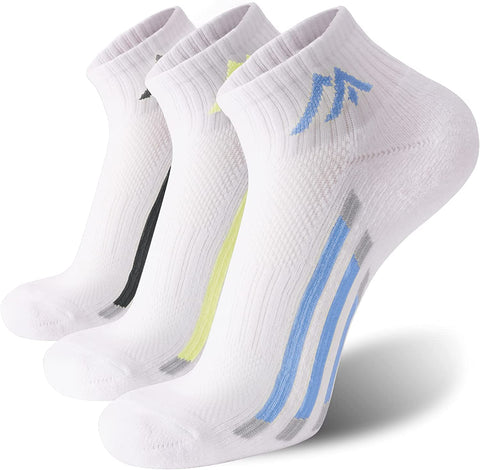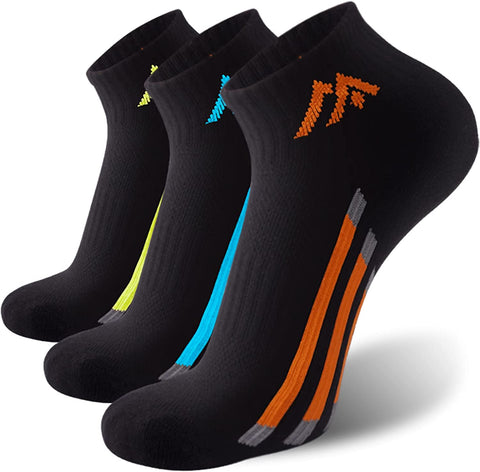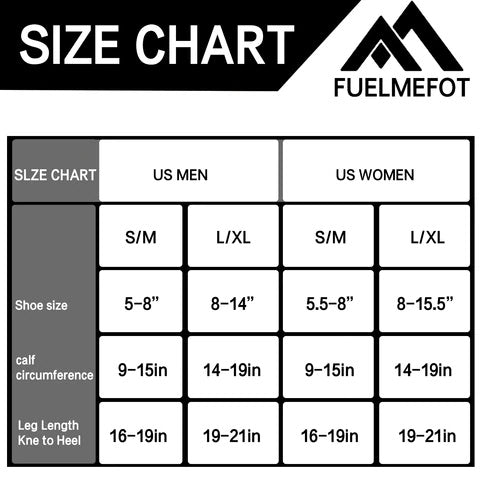How to choose the right compression socks: Benefit of copper compression socks
Introduction
So you have started hearing about these compression socks from friends, colleagues, and what have you. The constant praise and applaud for these seemingly new piece of attire has birthed a curiosity and interest inside you, but you are still relatively ill-informed regarding all the ins and outs of this new trend. If this sounds like we are talking about you, then sit back, relax and read on, as this article is all about educating you on compression socks as well as everything you need to know about it.
Good or bad?
Before we begin, though, it is worth mentioning that these favorite new garments are not for everyone. In addition to that, using these compression socks incorrectly can be detrimental to your health. So whether you have already been using compression socks or a fresh new or potential user, we will cover all the basics to using compression socks so not only are you fully prepared before you divulge in, but you are better informed of the risks and benefits that come along with compression socks.
What exactly are compression socks?
To understand the real and intended purposes and benefits that compression socks provide, we must dig deep into how our body operates and functions. You see, the blood in our bodies carries an important responsibility. What might that be, you ask? Well, in order for our bodies to function like they are supposed to, the blood in every part of our body must receive oxygen. Therefore, every individual has a circulatory system that essentially exists as a transportation component that allows the veins in our body to carry and transfer the blood along with the oxygen with it to each and every part of our body. This is more commonly understood and known as blood circulation.
The “asleep limb” feeling
You know how you sit at one place and in one position for too that leads to a numbness feeling, and how it prevents or excessively makes it difficult for you to make any movement? Well, that is a result of poor blood circulation; this happens because your veins are pressured so much that it blocks the transmission of blood through that specific area of your body.
Compression socks & circulation
In subjectively simpler words, your circulatory system takes the fresh, nutrient, and oxygen-rich blood from your heart to distribute it all throughout your body, and once that is done, the blood is depleted of oxygen and must travel back to the heart to replenish itself. Now, as for the nitty-gritty information, we must discuss the need for these compression socks.
The feet’s difficult feat
The blood in your legs and feet has more challenges and obstacles to overcome. What exactly might that be? Well, the gravity, of course. Due to the reason that your legs have to not only bear all the weight of your body, the depleted blood in your leg's veins has to fight gravity to travel back to the heart along with the added pressure and suffocation, so to speak, from the burden of your body weight. For this particular reason, the arteries and veins in your legs are much more prone to getting damaged and growing weaker with time. This is where compression socks come into play. These carefully and scientifically engineered stockings are designed with special materials that aid in providing the right amount of pressure that boosts and improves the blood circulation under your skin and whatever limb it is worn on top of.
Why else would you need compression socks?
Along with helping and improving circulation, compression socks have been proven to be capable of various other benefits and uses. Therefore, before you decide to buy compression socks, take a step back and really figure out why you would need a pair of this healthy piece of garments. To help you with that decision, let us have a look at the numerous purposes we have made a list of.
For better circulation
We have already discussed this particular application, but in general, if you are looking to improve circulation in your legs and feet or to keep muscles warm and rested, then you should seriously consider getting yourself a pair of compression socks.
Comfort
Are you seeking to have more comfort ability in your legs, perhaps due to long periods of standing or sitting? Then you already know what you need to do as compression socks have been proven to increase comfort. Additionally, looking after your physical health through the usage of these compression socks can significantly improve your overall health in the long term.
Surgery
Have you recently undergone limb surgery and are desperately in need of better circulation around that particular body part? If your answer is yes, then make sure to consult with your doctor before deciding to wear a compression sock on the operated limb. Not only will your doctor provide you with the utmost professional advice but may also guide you through the most suitable type of compression sock for your condition.
Travel
If you tend to travel quite often and are always left with painful, sore, and tired legs, then it might be an ideal situation to wear these compression socks during your traveling journeys to alleviate your discomfort and pain. After all, traveling can already have a heavy toll on your mental and emotional health, so the least you can do is take care of the physical health department.
Other medical conditions
Diabetes is increasingly becoming a more common condition among people today. If you are one of the many individuals suffering from the painful and swelling symptoms of this disease, then you are also probably going through its supplementary problem of poor circulation in your legs and feet. Needless to say, compression socks will surely improve the circulation around your feet to minimize the pain and discomfort diabetes can cause.
Regardless of the conditions, you may be going through, it is imperative to pinpoint the exact reason you may be needing a compression sock in order to identify the right type of compression sock for you.
Are compression socks completely safe to wear?
In general, compression socks pose a very minimal threat, especially if worn after considering and following all guidelines. However, there are some cases in which people may not want to wear these compression socks, especially if they have a skin type that can easily get irritated. In addition to that, another important thing to keep in mind in order to reduce as many complications as possible is to make sure the fitting of the compression socks is perfectly fine.
Following are some of the potential risks to keep in mind;
Can hinder or cut off circulation
This may sound like a bit of an oxymoron as this article has been persistent about the benefits to a person’s blood circulation these compression socks provide. But bear with us; there are some cases where these compression socks might hamper the blood circulation if the fitting is not right. This might happen if a compression sockis especially tighter than it should be, leading to poorer circulation than it may have been before.
Can bruise your legs
If you know that your skin is particularly dry or if you are regularly traveling to or in relatively dry climates, then your leg is more prone to getting chafed or grated. As a result, people may suffer from cuts or bruises that can linger on for a long time, and it does not help the fact that it was caused by the very thing meant to cure or heal your leg. However, please bear in mind that this phenomenon is much less likely to occur if the fitting of the compression sock is right and appropriate for you.
Skin irritation and itchiness
Similarly, if the fitting of your compression socks does not match with the size of your limbs, then you may inadvertently aggravate your skin which can lead to redness and itchiness around the edges of your limbs.
Consult with your doctor
The majority of manufacturers of these compression socks like to claim that their product is completely safe to wear all day and night without any additional provision or exceptions. However, this is obviously not the case, and each person who wears compression socks is likely to have their own unique reaction to this case according to individual medical conditions and histories along with the specific reason they are wearing it.
Therefore, it is highly recommended and could not be more emphasized that you discuss with your doctor all the details regarding the reasons you may be considering to start wearing compression socks. In addition to that, do not forget to go over the length of duration you should or should not be wearing the compression socks.
Safety measures to take and consider before wearing compression socks
The safest way to approach any new physical change is to definitely consult with and follow a healthcare professional’s guidance. Some people mistake purchasing over-the-counter compression socks that lead to complications in the long run. You do not and should not have to be one of those people and should opt for prescribed and medical-grade compression socks for your benefit. It must be clear at this point that harms and injuries caused by compression socks are only a product of neglected preparation prior to the actual use them.
Best practices for compression socks
These are the most appropriate practices you must adopt if you are considering to use compression socks.
Get the socks fitted.
Make sure you are able to get your compression socks tailored or fitted by a proper professional, and do not hesitate to bother him/ her until you are completely comfortable with the feel and fitting of the compression socks, keeping in mind that you may have to make future visits if this is not done beforehand.
Follow instructions
In addition to that, you should also not forget to have a proper read-through of the instructions that are provided directly by the manufacturers of the compression socks you chose.
Hygiene
As important as most other practices, we would like to advise you to hand wash your compression socks and hang them and leave it to dry to avoid any changes and hampering the quality of the fabric. Also, not to mention the elimination of potential bacteria that can accumulate while you wear the compression socks, which may possibly lead to an increase in the risk of infection or other diseases.
Updating the size of the compression socks
Just how we change our wardrobe and update the size of our clothing, it should not be different for compression socks. We all grow into different sizes and whatnot; therefore, you should make sure to update the fitting of your compression socks to avoid the problems that can otherwise occur. Lastly, speaking of size changes, it is perfectly normal to gain or lose weight that can lead to the same situation and requirement of altering your compression sock’s fitting, so make sure to remain aware of that.
Get a fresh pair of compression socks.
In the case that you notice your current compression sock losing its original fitting and stretch, it is advised to switch it with a brand new pair after approximately 25-30 wears to maximize the benefits of a good quality compression sock.
Regularly take them off.
Last but not least, in order to remove the possibility of your compression sock becoming one with your limbs, so to speak, it would be wise to take off your compression socks from time to time to prevent it from adhering to your skin and becoming difficult to remove.
Copper’s role in compression socks
Copper has been established as an antimicrobial material by the Environmental Protection Agency (EPA). But what does that mean? According to studies, copper has been found to carry anti-microbial properties and is deemed "contact killing." This means that bacteria, yeast, and viruses are almost instantly killed upon physical contact with the surface of copper.
Do you see where we are going with this? Essentially, this means that copper can be a good addition to compression socks with the aim of killing odor produced from feet sweat. However, as convenient as this may be, researchers have found no particular evidence of copper being effective in treating poor blood circulation and other problems such as pain and discomfort that are traditionally healed by a compression sock.
Copper compression sock vs. non-copper compression socks
In general, there is not really any professional evidence on whether a person who uses copper-infused compression socks gets more benefits in terms of preventing blood circulation-related problems or gaining faster recovery as opposed to a non-copper compression sock user, besides the benefit of odor elimination.
In essence, there needs to be an increase in the frequency of researches conducted purely for the purpose of finding whether copper plays a bigger role than just eliminating the bad smell from wearing compression socks. However, if there was confusion regarding whether you should opt for a copper-infused compression sock rather than a non-copper, then the choice is quite obvious, a better smelling feet is nothing but an additional benefit.
Types of compression socks:
There are generally three types of primary compression socks. Which are as follows
- Non-medical support hosiery
- Graduated compression socks
- Anti-embolism compression socks
Non-medical support hosiery
Non-medical support hosiery compression socks are the more commonly known over-the-counter products that can be bought by anyone, through a pharmacy, or online. These socks come in a variety of sizes, lengths, and stretch that you can choose from according to your particular conditions and needs. In addition to that, you can choose from different pressure levels to support your own conform level. Along with that, there are many colors, fabrics and patterns these compression socks come in to match any individual unique preferences.
Graduated compression socks
These are compression socks that can only be obtained through a real prescription from a medical professional therefore are the safest and reliable compression socks. In addition to that, these specific items of garments can be properly fitted and perhaps tailored by a professional coupled with sound advice on how to use them safely. In order to get a prescription, you must provide your doctor with the exact specific reasons you are seeking a pair of compression socks,but the ultimate factor depends on if you are medically eligible and have a relevant condition in which you may need to wear these garments. Moreover, your provider must guide you through how long and frequent you should wear the compression socks, among other instructions.
Anti-embolism compression socks
Anti-embolism compression socks are only prescribed for people who are suffering from pulmonary embolism. What is pulmonary embolism and why you must know before you decide to buy a pair of compression socks? A pulmonary embolism is a disease that affects an individual’s lungs. It relates to damages in the person's lungs due to a shortage of oxygen levels in the blood, restricted blood circulation, and is essentially caused by a blood clot. This type of compression socks is normally given to people with restricted and minimal mobility.
Choosing the right length of compression socks
Selecting the most appropriate compression socks for you depends on the functionality you are looking for, which is directly tied to the amount of support your limb needs. There are different lengths of compression socks, each with its specific purpose. For example, if you are an athlete, then you may choose knee-high compression socks that will provide support to the majority of your leg.
On the other hand, if you only need coverage and assistance for your feet, then a low-rise compression sock should do the trick. Similarly, if you wish to alleviate pains up to your calves, then a mid-calf compression sock would be a perfect fit. The latter two are more so for daily applications as they can fit comfortably underpants and provide for a day's worth of comfort and assistance.
The desired compression for you
The increase in the use of compression socks is mostly been due to recreational uses. Therefore, we have identified the right level of compression for this particular case. Compression socks for leisure purposes should fall in lower- compression levels that are in the range of 15-20 mmHg. Whereas middle compression levels in the range of 20-30 mmHg are typically advised to users who are looking to alleviate mild discomfort or pain.
Generally, you should not have a problem finding compression socks in the compression level of around 15-30 mmHg, perhaps at your local drug store. However, as far as higher compression level compression socks are concerned, you will most likely need to consult a doctor to prescribe it for you directly and specifically on the basis of your condition.
Conclusion
Compression socks are generally safe to use and are becoming more and more common due to their reputable reliability and performance. Add to that a medical professional’s guidance coupled with a read-through and compliance of the instructions given by the compression sock's manufacturer, and you should have no negative side effects to deal with. On the contrary, long-term use of compression socks or overusing them can lead to skin damage and may even create conditions for infection. If you are getting more and more dependent on compression socks, then it would be a wise choice to consult with a doctor and switch over to a pair of medical-grade compression socks. Lastly, if you start to notice even the slightest hints of negative side effects such as broken or reddish skin, then you should definitely and immediately discontinue using the compression socks as they may gradually worsen the condition.
Make sure to ask your doctor for the precise wear time recommended for your condition and comply accordingly.









































